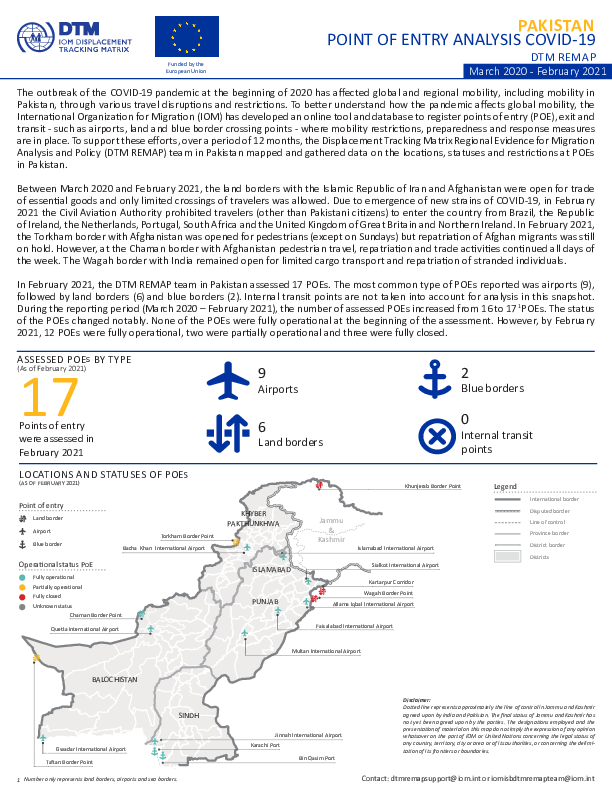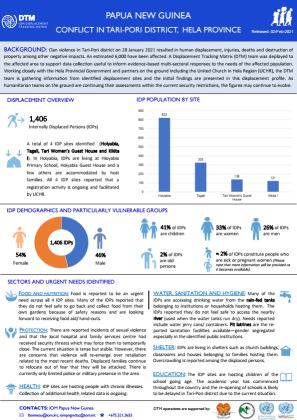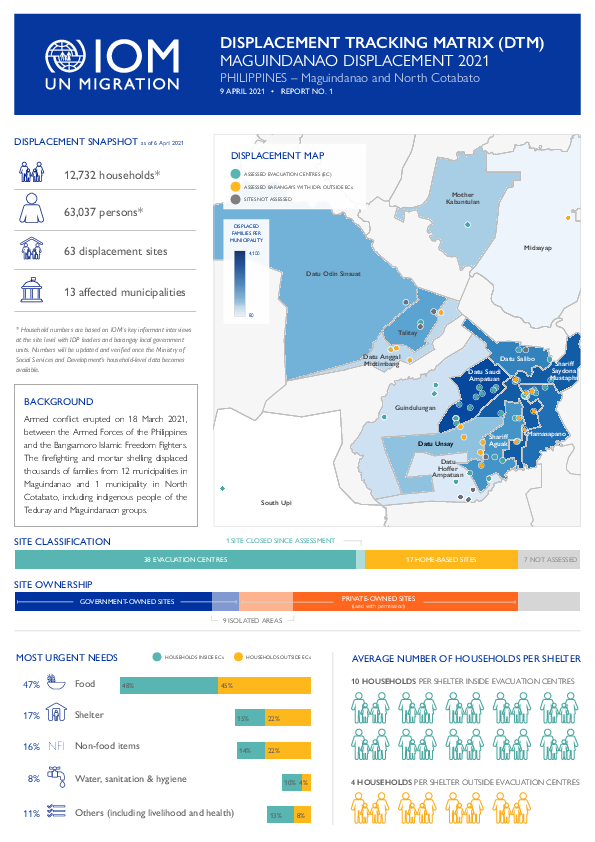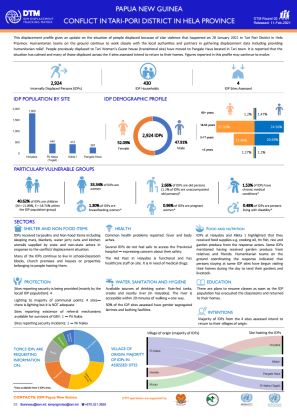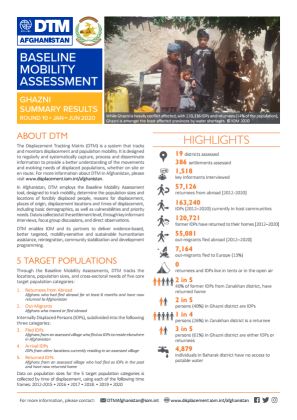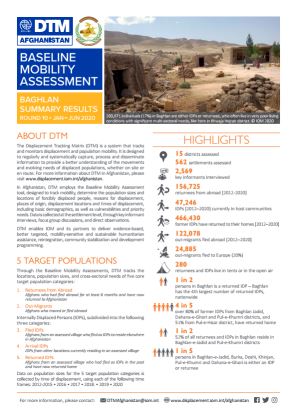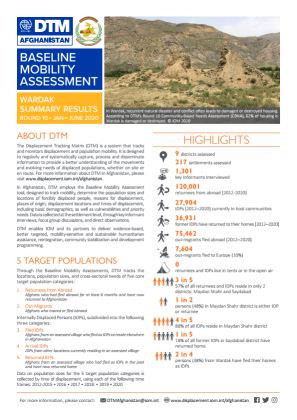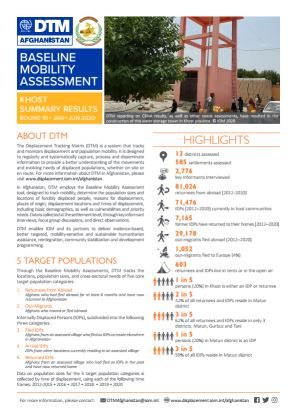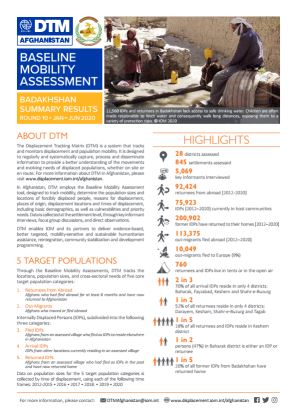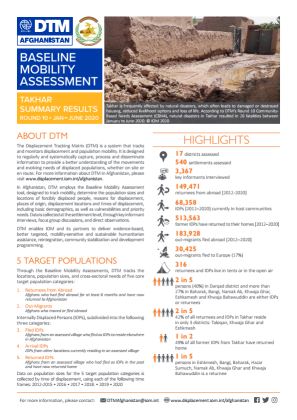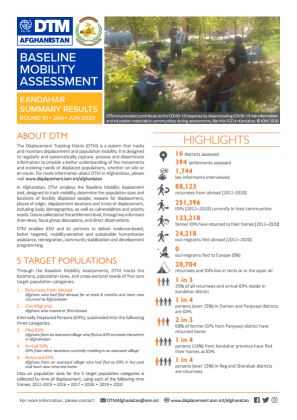-
Countries
-
Data and Analysis
-
Special Focus
-
Crisis Responses
Asia and the Pacific
DTM Asia and the Pacific
DTM Operations in the region
- Active DTM operation
- Past DTM operation
Para obtener resultados de búsqueda más avanzados, vaya a la Página de búsqueda avanzada de informes
Pakistan - Flow Monitoring of Undocumented Afghan Returnees from Pakistan (28 March - 10 April 2021)
IOM Pakistan collects data on the outflows of undocumented Afghan migrants at the Torkham and Chaman border crossing points in an effort to better understand the migration movements of undocumented Afghan migrants returning to Afghanistan from Pakistan.
Point of Entry (PoE) — COVID-19 – Dashboard Pakistan (March 2020 – February 2021)
The outbreak of the COVID-19 pandemic at the beginning of 2020 has affected global and regional mobility, including mobility in Pakistan, through various travel disruptions and restrictions.
Papua New Guinea — Conflict In Tari-Pori District In Hela Province (2 February 2021)
Clan violence in Tari-Pori district on 28 January 2021 resulted in human displacement, injuries, deaths and destruction of property among other negative impacts. An estimated 6,000 have been affected.
Philippines — Displacement Snapshot - Maguindanao and North Cotabato (9 APRIL 2021)
Armed conflict erupted on 18 March 2021, between the Armed Forces of the Philippines and the Bangsamoro Islamic Freedom Fighters.
Papua New Guinea — Conflict in Tari-Pori District in Hela Province (11 February 2021)
This displacement profile gives an update on the situation of people displaced because of clan violence that happened on 28 January 2021 in Tari Pori District in Hela Province.
BMA R10 — Afghanistan — Helmand Baseline Mobility Assessment Summary Results (January—June 2020)
In Afghanistan, DTM employs the Baseline Mobility Assessment tool, designed to track mobility, determine the population sizes, locations and geographic distribution of forcibly displaced, return and migrant populations, reasons for displacement, places of origin, and times of displacement, as wel
DTM REMAP— Point of Entry Analysis COVID-19 (March 2020 - February 2021)
The outbreak of the COVID-19 pandemic at the beginning of 2020 has affected global and regional mobility, including mobility in the DTM REMAP project countries, through various travel disruptions and restrictions.
BMA R10 — Afghanistan — Ghazni Baseline Mobility Assessment Summary Results (January—June 2020)
In Afghanistan, DTM employs the Baseline Mobility Assessment tool, designed to track mobility, determine the population sizes, locations and geographic distribution of forcibly displaced, return and migrant populations, reasons for displacement, places of origin, and times of displacement, as wel
BMA R10 — Afghanistan — Kabul Baseline Mobility Assessment Summary Results (January—June 2020)
In Afghanistan, DTM employs the Baseline Mobility Assessment tool, designed to track mobility, determine the population sizes, locations and geographic distribution of forcibly displaced, return and migrant populations, reasons for displacement, places of origin, and times of displacement, as wel
BMA R10 — Afghanistan — Kunduz Baseline Mobility Assessment Summary Results (January—June 2020)
In Afghanistan, DTM employs the Baseline Mobility Assessment tool, designed to track mobility, determine the population sizes, locations and geographic distribution of forcibly displaced, return and migrant populations, reasons for displacement, places of origin, and times of displacement, as wel
BMA R10 — Afghanistan — Nimroz Baseline Mobility Assessment Summary Results (January—June 2020)
In Afghanistan, DTM employs the Baseline Mobility Assessment tool, designed to track mobility, determine the population sizes, locations and geographic distribution of forcibly displaced, return and migrant populations, reasons for displacement, places of origin, and times of displacement, as wel
BMA R10 — Afghanistan — Parwan Baseline Mobility Assessment Summary Results (January—June 2020)
In Afghanistan, DTM employs the Baseline Mobility Assessment tool, designed to track mobility, determine the population sizes, locations and geographic distribution of forcibly displaced, return and migrant populations, reasons for displacement, places of origin, and times of displacement, as wel
BMA R10 — Afghanistan — Baghlan Baseline Mobility Assessment Summary Results (January—June 2020)
In Afghanistan, DTM employs the Baseline Mobility Assessment tool, designed to track mobility, determine the population sizes, locations and geographic distribution of forcibly displaced, return and migrant populations, reasons for displacement, places of origin, and times of displacement, as wel
BMA R10 — Afghanistan — Wardak Baseline Mobility Assessment Summary Results (January—June 2020)
In Afghanistan, DTM employs the Baseline Mobility Assessment tool, designed to track mobility, determine the population sizes, locations and geographic distribution of forcibly displaced, return and migrant populations, reasons for displacement, places of origin, and times of displacement, as wel
BMA R10 — Afghanistan — Faryab Baseline Mobility Assessment Summary Results (January—June 2020)
In Afghanistan, DTM employs the Baseline Mobility Assessment tool, designed to track mobility, determine the population sizes, locations and geographic distribution of forcibly displaced, return and migrant populations, reasons for displacement, places of origin, and times of displacement, as wel
BMA R10 — Afghanistan — Herat Baseline Mobility Assessment Summary Results (January—June 2020)
In Afghanistan, DTM employs the Baseline Mobility Assessment tool, designed to track mobility, determine the population sizes, locations and geographic distribution of forcibly displaced, return and migrant populations, reasons for displacement, places of origin, and times of displacement, as wel
BMA R10 — Afghanistan — Khost Baseline Mobility Assessment Summary Results (January—June 2020)
In Afghanistan, DTM employs the Baseline Mobility Assessment tool, designed to track mobility, determine the population sizes, locations and geographic distribution of forcibly displaced, return and migrant populations, reasons for displacement, places of origin, and times of displacement, as wel
BMA R10 — Afghanistan — Logar Baseline Mobility Assessment Summary Results (January—June 2020)
In Afghanistan, DTM employs the Baseline Mobility Assessment tool, designed to track mobility, determine the population sizes, locations and geographic distribution of forcibly displaced, return and migrant populations, reasons for displacement, places of origin, and times of displacement, as wel
BMA R10 — Afghanistan — Paktya Baseline Mobility Assessment Summary Results (January—June 2020)
In Afghanistan, DTM employs the Baseline Mobility Assessment tool, designed to track mobility, determine the population sizes, locations and geographic distribution of forcibly displaced, return and migrant populations, reasons for displacement, places of origin, and times of displacement, as wel
BMA R10 — Afghanistan — Badakhshan Baseline Mobility Assessment Summary Results (January—June 2020)
In Afghanistan, DTM employs the Baseline Mobility Assessment tool, designed to track mobility, determine the population sizes, locations and geographic distribution of forcibly displaced, return and migrant populations, reasons for displacement, places of origin, and times of displacement, as wel
BMA R10 — Afghanistan — Takhar Baseline Mobility Assessment Summary Results (January—June 2020)
In Afghanistan, DTM employs the Baseline Mobility Assessment tool, designed to track mobility, determine the population sizes, locations and geographic distribution of forcibly displaced, return and migrant populations, reasons for displacement, places of origin, and times of displacement, as wel
BMA R10 — Afghanistan — Daykundi Baseline Mobility Assessment Summary Results (January—June 2020)
In Afghanistan, DTM employs the Baseline Mobility Assessment tool, designed to track mobility, determine the population sizes, locations and geographic distribution of forcibly displaced, return and migrant populations, reasons for displacement, places of origin, and times of displacement, as wel
BMA R10 — Afghanistan — Ghor Baseline Mobility Assessment Summary Results (January—June 2020)
In Afghanistan, DTM employs the Baseline Mobility Assessment tool, designed to track mobility, determine the population sizes, locations and geographic distribution of forcibly displaced, return and migrant populations, reasons for displacement, places of origin, and times of displacement, as wel
BMA R10 — Afghanistan — Kandahar Baseline Mobility Assessment Summary Results (January—June 2020)
In Afghanistan, DTM employs the Baseline Mobility Assessment tool, designed to track mobility, determine the population sizes, locations and geographic distribution of forcibly displaced, return and migrant populations, reasons for displacement, places of origin, and times of displacement, as wel
Pagination
Para obtener resultados de búsqueda más avanzados, vaya a la Página de búsqueda avanzada de conjuntos de datos
Pagination
- First page
- Previous page
- 1
- 2
- 3
- 4
- 5
- 6
Pagination
- First page
- Previous page
- 1
- 2
- 3
- 4
- 5
- 6
- 7

